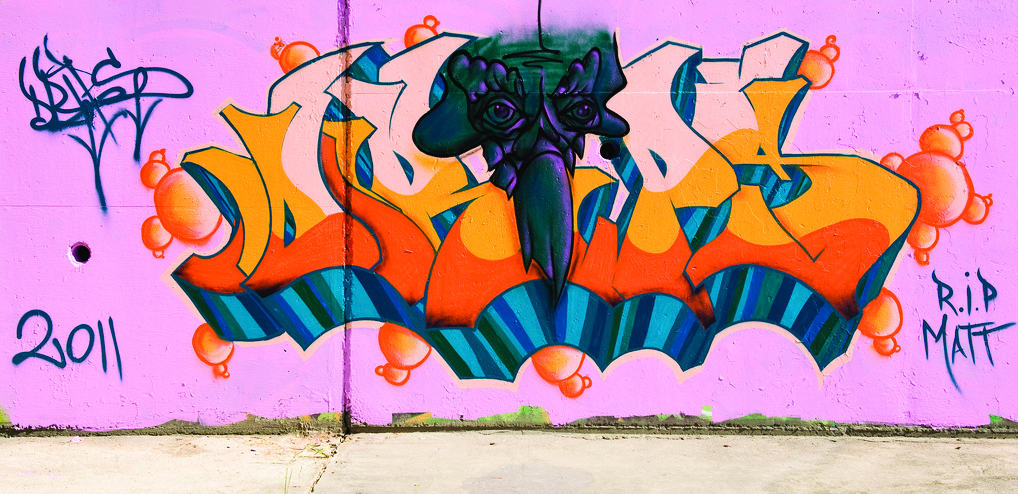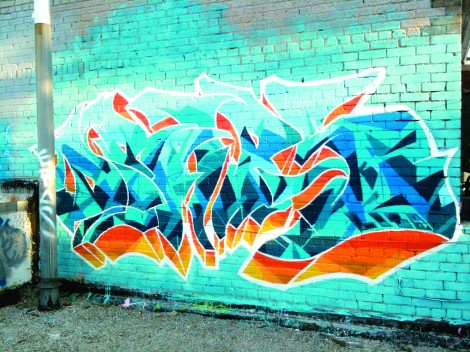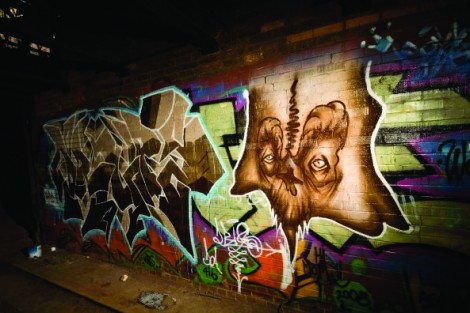I hear sirens and freeze, bracing myself for the worst — but my companions are unfazed.
“Don’t worry, it’s not for us,” Drips says calmly, sensing my apprehension. Drips is a local Toronto graffiti artist; he and his friend are working on an underpass near Jane and the 401 and have agreed to let me tag along.
For most, graffiti appears out of thin air: one day there is a blank wall, the next a slab of colour — but the transformation process is never witnessed. To the ordinary observer, Drips and his fellow artists are invisible. Our location was suggested to him by another graffiti artist. It turns out the graffiti community is a very small and tightknit group. Although there is a sense of camaraderie, there is also a lot of competition.
“You can’t make a move without someone finding out what you did,” Drips tells me.
Taggable spaces are limited. Erasure and overwriting of previous works is very common and artists often try to upstage one another. Eventually things get resolved because, as Drips jokingly explains, it ends up costing too much money in paint to continue.
“But there are rules. I never paint over the work of someone I respect. If I can see the work took seven hours to complete, I’m not going to do a quick piece over it. I’ll only paint over it if I think I can make it better.”
Bundled up and eager to get started, I follow Drips to a location near the highway exit ramp. The trek to the location is a wet and muddy one. Eventually, we end up beneath the bridge of the highway, which has a large collection of graffiti pieces.
“This is a nice collection right here,” Drips’ friend points out to me. And it certainly is. I never expected such a vibrant gallery of graffiti beneath a highway bridge.
“That’s Poser’s,” Drips says in passing. Some graffiti artists have a character, a marker identifying the artist; Poser’s is a rabbit, and Drips’ is a skull.
Climbing onto a ledge, Drips begins to unpack his equipment: paint for buffing, rollers, and most importantly a couple dozen spray cans. Picking a location near the edge of a ledge, Drips paints over a previous work.
“You see here, it has water damage,” Drips says while pointing out an area where the paint has faded. “It had a good run.”
While Drips works, I ask him what graffiti means to him.
“What doesn’t it mean to me?” he answers back with a smile.
For Drips, graffiti is about self-expression. For others, it’s synonymous with vandalism.
“There are rules. Don’t do it on private property: not on cars, houses, schools, or churches. There are these scums of the earth who just tag anything and then all of us are labelled punks and vandals … [There was] one guy who used to draw swastikas around the city — that’s not graffiti. Those are scribbles.”
Drips also adds that graffiti is particular to specific environments.
“Graffiti doesn’t belong in a place like Rosedale. It belongs to neighbourhoods like this one,” he says, pointing out the billboards that surround us.
“You can’t walk around them. If you have money, you can put up an ad. People don’t get a say in what they see.”
For Drips, graffiti is self-expression for those who don’t have the money to have their voices heard. Graffiti, he says, belongs in public spaces. He calls it the biggest art movement since the Renaissance.
Three hours in, my limbs are completely frozen, while Drips continues to paint with his black latex gloves. Drips and his friend discuss escape routes in case the police show up, the mere thought of which gets my blood flowing again.
I ask Drips if he sees graffiti as an art form. For him, the answer is a resounding yes. He tells me of a recent and rather embarrassing incident during Rob Ford’s anti-graffiti campaign. In a bid to rid the city of graffiti, the anti-graffiti team buffed out a piece commissioned by the city itself. Putting the irony of the incident aside, the very act of commissioning graffiti lends a hand to legitimizing it. Drips does not argue that all graffiti is art; he simply asks for a more honest and complex dialogue about it.
“The major problem is that people don’t even try to get it. They dismiss it right away. People are just told to see it all as vandalism. There is no discussion. Look at the States. Some dudes just chiseled some faces into a mountain; did they ask the Natives if they wanted those faces there?”
As I adjust to the cold, I pick up a can of spray paint. The front has a drawing of a boy in a baseball hat, pointing a spray can at a brick wall covered with colourful, stylized letters. As I turn the can around, the irony of the warning on the back strikes me. “Product was designed for artistic work. Any use of this product for acts of vandalism will be subject to severe legal penalties.”
Perhaps in the future the line between art and vandalism will not be so hastily drawn.




